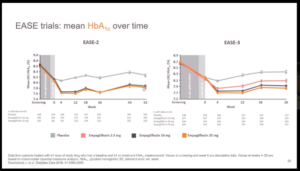ADA Presidents’ Select Abstract: Symptom Responses to Hypoglycemia Are Related to Connectivity Change between the Thalamus and Frontal Lobes
PETER JACOB presented his study at the the 80th scientific session of ADA. In people with or without type 1 diabetes, neuroimaging studies highlight the importance of thalamic activation in response to hypoglycemia. This activation is characteristically attenuated in impaired awareness of hypoglycaemia (IAH), a major risk factor for severe hypoglycemia. The authors investigated changes in connectivity of the thalamus with other brain regions during hypoglycemia.
In the study, fourteen people without diabetes (no diabetes, ND), 15 with T1D and normal awareness of hypoglycemia (NAH) and 22 with IAH, all right-handed, age, sex and gender matched, underwent a hyperinsulinemic glucose clamp during which the authors acquired blood oxygen level dependent fMRI at euglycemia (90mg/dL) and at onset of hypoglycemia (48mg/dL). CONN toolbox in SPM12 was used to study connectivity. A thalamic seed was used in a seed-tovoxel analysis with and without the increase in symptoms at hypoglycemia as an explanatory regressor variable. The study results showed that symptom scores in response to hypoglycemia rose earliest and to the greatest levels in NAH (11.0 to 18.3, p= 0.029). The rise in symptom scores in ND was not significant at this timepoint (9.2 to 13.8, p= 0.057), whilst IAH showed no symptom change (10.5 to 9.8, p= 0.7). In ND, hypoglycemia increased thalamic connectivity with the right frontal pole (p = 0.018). This did not occur in diabetes, either in NAH or IAH. The NAH group demonstrated a positive relationship between change in symptoms with change in connectivity of the thalamus and a left frontal pole region (p = 0.035), whereas an overlapping area had a negative correlation in ND (p = 0.001). There was no correlation in IAH.
Conclusion: During hypoglycemia, those with T1D display aberrantly enhanced thalamic connectivity with brain regions responsible for complex behavior. Disruption of this network occurs in IAH and may be the mechanism for failure of perception of the onset of hypoglycemia and reduced hypoglycaemia avoidance behaviors, increasing severe hypoglycemia risk.
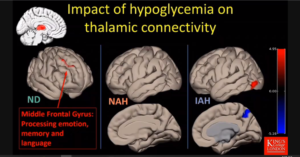
Association of Frequency of Hypoglycemic Episodes with Incident Cardiovascular Events in Adults with Type 2 Diabetes Mellitus: A National Database Study
OMAR A. ALABER et.al. conducted a study to evaluate the association of frequent hypoglycemic episodes (> 5/year) with incident CV events in adults with type 2 diabetes mellitus (T2DM). This study was presented at the 80th scientific session of ADA. They queried a national database (IBM Explorys Solutions, IBM, Inc.) for adults with T2DM who had >5 hypoglycemic episodes (cases) vs. 1 to 5 hypoglycemic episodes (controls) in one year.
Primary endpoints of the study were overall CV adverse events, acute myocardial infarction (MI), cerebrovascular accident (CVA) and cardiac arrhythmias. Odds ratios (OR) and 95% confidence interval (CI) for the OR were calculated for the risk of association between number of hypoglycemic episodes and incident CV events. 4,882,710 patients from a total of 61,917,780 had T2DM. Patients with >5 hypoglycemic episodes in 1 year (cases) had a higher incident risk of overall CV adverse events when compared to controls (OR: 1.61, 95% CI: 1.558, 1.663). In the stratified analysis, patients with frequent hypoglycemic episodes had a significantly higher incidence of cardiac arrhythmias, acute MI, and CVA (Table 1).
Conclusion: Patients with T2DM with frequent hypoglycemic episodes (>5/year) tend to have higher incidence of adverse CV events.
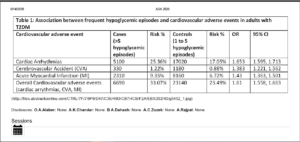
Interrelationship between Hypoglycemia (HYPO) and Cardiovascular (CV) and Mortality Outcomes in the CAROLINA Trial
JULIO ROSENSTOCK presented the relationship between Hypoglycemia (HYPO) and Cardiovascular (CV) and Mortality Outcomes in the CAROLINA Trial. This study was presented at the 80th scientific session of ADA. The CAROLINA trial evaluated 6033 subjects for CV safety of linagliptin (LINA) and glimepiride (GLIM) in relatively early type 2 diabetes (T2D) and elevated CV risk (mean age 64.0 years, HbA1c 7.2%, median T2D duration 6.3 years) and demonstrated non-inferiority for 3P-MACE and no difference for CV and mortality outcomes.
A significant lower risk of HYPO was observed with LINA vs. GLIM regardless of severity classification. The study assesed, in 6014 participants, the associations between severe HYPO and/or documented HYPO (BG <54 mg/dl), which occurred in 109/3014 (3.6%) and 537/3000 (17.9%) in the LINA and GLIM groups, respectively (HR 0.19 [95% CI 0.15, 0.23]), and CV and mortality outcomes using Cox regression models. HYPO events preceded CV outcomes in 0.0-3.6% of all events with LINA and in 8.0-26.2% events with GLIM. Notably, even when multivariably adjusted, occurrence of HYPO was associated only with higher risk for all-cause mortality (HR 1.49 [1.16, 1.92]), and non-CV mortality (HR 2.16 [1.57, 2.97]) (Fig A). Antecedent HYPO did not influence the relative effect of LINA vs. GLIM on any CV or mortality outcome (Fig B).
Conclusion: The study concluded that preceding HYPO was associated with higher risk for all-cause and non-CV mortality, but not with any other outcomes in a relatively early T2D population at elevated CV risk.
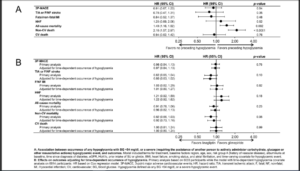
Association of Timing of Physical Activity Bouts with Cardiorespiratory Fitness in Adults with Type 2 Diabetes in the Look AHEAD Study
JINGYI QIAN et.al.conducted a study to evaluate association of timing of physical activity bouts with cardiorespiratory fitness in adults with Type 2 Diabetes in the Look AHEAD study. This study was presented at the 80th scientific session of ADA. Moderate-to-vigorous physical activity (MVPA) contributes to be an important treatment in type 2 diabetes (T2D). Few studies examine the timing of MVPA, as there are no established methods to characterize the MVPA bout timing throughout the day. The authors determined the timing of MVPA bouts in adults with T2D, and examined whether cardiorespiratory fitness and odds of cardiovascular disease (CVD) history relate to timing of MVPA bouts in men and women.
In the study, baseline data from Look AHEAD participants (n=2153, 57% women) were analyzed. Cardiorespiratory fitness evaluated by VO2max test was expressed as METs. MVPA bouts (≥3METs in ≥10mins bouts) were determined using the hip-worn RT3 accelerometer for 7 days. Participants were divided into six groups based on the time of day with the major amount of MVPA bouts (MET-min): ≥50% of MVPA bouts during the same time window (Early morning, Late morning, Afternoon, or Evening, N=214-280/group), <50% of MVPA bouts in any time category (Mixed; reference group, N=436), and ≤1 day with MVPA bouts per week (Inactive, N=624).
The study results showed that cardiorespiratory fitness differed by timing of MVPA bout category (P<0.0001). In a multivariate adjusted model, the association of timing of MVPA bouts with fitness varied by sex (P=0.002). In women, the evening group had higher fitness (β 0.35 [0.04, 0.66] METs). After further adjustment for individual total bout-MVPA (MET-min) per week, in men, the early morning group was associated with higher fitness (β 0.46 [0.06, 0.85] METs). Interestingly, in men, but not in women, the early morning group also had higher odds of CVD history (OR 2.4 [1.38, 4.21]).
Conclusion: The study findings concluded that higher cardiorespiratory fitness associated with evening MVPA bouts in women, and with early morning MVPA bouts in men.

ADA Presidents’ Select Abstract: The Affordable Care Act Medicaid Expansion Correlated with Reduction in Lower Extremity Amputation among Minorities with Diabetic Foot Ulcerations
TZE-WOEI TAN presented his study at the 80th scientific session of ADA. Lack of insurance and non-white race are associated with increased risks of amputation. It is unclear how expanded insurance coverage affects the care of minorities with diabetes. The author’s aim was to evaluate the effect of Medicaid expansion under the Affordable Care Act (ACA) on outcomes of minorities with diabetic foot ulcerations (DFUs).
Tzei and team analyzed the State Inpatient Databases from 19 states to identify people who were either uninsured or on Medicaid with DFUs from 2013 to 2015. Patients were categorized into early-adopter states (implemented the ACA expansion by January 2014) and non-adopter states. In order to examine the effects of state type (early vs. non-adopter), time (pre- vs. post-ACA), and their interaction on the proportion of amputation, logistic regression was performed.
The study comprised of 25,493 non-white Medicaid beneficiaries and 9,863 uninsured patients with DFUs. Among the minorities aged 20 to 64 years, there was an increase (180.7%) in the number of admissions for Medicaid beneficiaries and a reduction (21.5%) in the admissions of uninsured patients in early-adopter states after expansion. In comparison, there was an increase in the number of admissions of the uninsured patients (78.2%) in non-adopter states during the same period. The odds of major amputation among non-white Medicaid beneficiaries with DFUs decreased 17.3% in early-adopter states and increased 0.9% in non-adopter states (p=0.045), while the odds of minor amputation increased 14% in early-adopter states and decreased 8.1% in non-adopter states (p=0.003).
Conclusion: In the care of minorities with DFUs, the ACA Medicaid expansion appears to have substantial positive effects Racial and ethnic minorities in states that expanded Medicaid experienced a significant reduction in the number of uninsured with DFUs and a reduction in major amputations. The broadening of the ACA may reduce disparities in diabetes-related amputations.
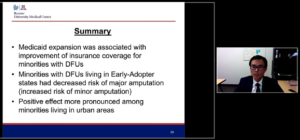
Impaired Awareness of Hypoglycemia and Maternal/Neonatal Outcomes in the CONCEPTT Trial
JASMINE BAHRAMI et.al. presented the CONCEPTT trial at the 80th scientific session of ADA. Patients with diabetes and impaired awareness of hypoglycemia (IAH) are at higher risk of severe hypoglycemia (SH). Pregnancy period marks an increase in IAH. To date, maternal and neonatal outcomes of pregnant women with hypoglycemia unawareness or SH has not been well described. In order to study the same, examined maternal and neonatal outcomes in women with IAH compared to women with normal awareness of hypoglycemia (NAH).
Jasmine et.al. included 214 pregnant women with type 1 diabetes who participated in the CONCEPTT trial. Participants finished Hypoglycemia Fear Surveys (HFS-II) at baseline and study completion. Post-hoc analysis of data was conducted using logical regression analysis to estimate the odds of occurrence of events by IAH versus NAH. The role of continuous glucose monitoring (CGM) use on outcomes was also examined.
The study results showed overall, 30% of participants reporting IAH (n=64). Women with IAH had more episodes of SH during pregnancy (mean 0.44 vs. 0.08, p<0.001). Women with IAH scored significantly higher on the HFS-II worry scale (25.9 vs. 20.1, p 0.0036), indicating more fear of hypoglycemia at baseline. They also used to spend more time below range (<63 mg/dl) at 12 weeks gestation. Higher overall HFS-II scores were associated with a higher risk of maternal SH episodes (RR 1.78, 95% CI 1.39-2.27) and a lower incidence of neonatal hypoglycemia (OR 0.597, 95% CI 0.385-0.893). No other differences in obstetric/neonatal outcomes between women with IAH and NAH was observed in the study. Higher HFS-II scores were associated with more diabetes-related complications, such as nephropathy (OR 1.907, 95% CI 1.06-3.4), independent of duration of diabetes. Lastly, CGM did not affect incidence of SH (RR 0.54, 95% CI 0.12 – 2.16).
Conclusion: In Type 1 diabetic pregnant women, IAH is associated with more maternal SH episodes and more fear of hypoglycemia. In the study, fear of hypoglycemia was associated with reduced neonatal hypoglycemia as well as more maternal diabetes-related complications.
Integrative Multiomics Analysis of Glucometabolic Traits, Adipose Tissue DNA Methylation, and Gene Expression Identifies Epigenetic Regulatory Mechanisms of Insulin Resistance and Obesity in African Americans
NEERAJ K. SHARMA, et.al conducted a study to better understand regulatory mechanisms of Insulin resistance and obesity in African Americans. This study was presented at the 80th scientific session of ADA. Decline in insulin sensitivity due to dysfunction of adipose tissue (AT) marks to be one of the earliest pathogenic events in type 2 diabetes. The author hypothesizes that differential DNA methylation (DNAm) in regulatory regions of a subset of genes controls insulin sensitivity and obesity by modulating transcript expression in AT. Integrating reduced representation bisulfite sequencing-derived AT DNAm profiles for 1,054,719 CpG sites and 200,800 CpG regions with AT transcript profile data in 230 African Americans, we performed cis-expression quantitative trait methylation (cis-eQTM) analysis focused on 6,774 glucometabolic trait associated transcripts to identify local epigenetic regulatory loci for these transcripts.
The author identified significantly associated CpG regions for 140 transcripts (FDR-P<0.1). The strongest eQTM locus was observed for the proopiomelanocortin (POMC; ρ= -0.632, P = 4.70X10 ) gene at the chr2:25,384,001- 25,385,000 region covering a CpG island in the gene. Epigenome-wide association studies (EWAS) further examined the association of DNAm levels of CpG sites/regions with insulin sensitivity (Matsuda index and S) and BMI. EWAS identified 520, 154, and 482 CpG regions associated (FDR-P <0.1) with Matsudaindex, S and BMI, respectively. We jointly analyzed the EWAS, transcript level to trait association, and eQTM data and identified significant eQTM loci for 26, 15 and 25 genes that were also associated with Matsuda index, S and BMI, respectively in EWAS. These associated genes include fructose-2,6- biphosphatase 3 (PFKFB3), integrin alpha M (ITGAM), integrin alpha X (ITGAX), and POMC.
Conclusion: Applying an integrative multi-omics approach, the study provided an evidence for DNAm-mediated regulation of gene expression at both previously identified and novel loci for many key AT transcripts influencing insulin resistance and obesity.
Cardiac Autoantibodies (AB) Predict Cardiovascular Disease (CVD) in T1D and Are Associated with Cytokine Signatures Linked to CVD Risk
Giovane R Sousa presented the study at the 80th 80th scientific session of ADA. CVD is the leading cause of mortality in T1D; however, only ~50% of this risk is explained by traditional risk factors. Recent studies show that subjects with T1D in the DCCT developed cardiac autoimmunity, defined by the presence of ≥2 Ab.
The author tested the hypothesis that some of the unexplained CVD risk in T1D is mediated by Ab-linked cytokine pathways. Ab in serum from 892 post-DCCT EDIC subjects (mean age 49 and T1D duration 28 years), with no CVD events at baseline was measured (Figure). Cumulative incidence of a first CVD event in subjects with 0, 1, and >2 Ab was 2.0%, 8.9%, and 43%, respectively, over 4-year median follow-up. In Cox regression models, ≥2 Ab predicted CVD events with minimal attenuation by known risk factors. Using a 42-plex array to measure baseline serum cytokines in subjects with ≥2 Ab and matched controls without Ab, the ≥2 Ab group showed 3.4-fold odds (95% CI, 1.6-6.1; P <0.0001) of having a 1 tertile increase in a proinflammatory component comprising IFN-γ, TNF-α, G-CSF, MDC, IL1-RA, IL-8, and EGF. Risk of CVD events was also independently associated with IFN-γ, TNF-α, and G-CSF levels (HR, 5.4; 95% CI, 1.5-18.9; P = 0.009).
Conclusion: In conclusion, in this cohort with longstanding T1D, cardiac Ab identified subjects at high risk for CVD events, potentially through Ab-linked cytokine pathways. These findings raise the possibility to immunologically predict and prevent CVD in T1D.

RISE Study continues to provide insight into progression of type 2 diabetes in youth
Ongoing data analyses from the RISE Study continue to shed light on important differences between adults and youth in the onset and progression of type 2 diabetes. A panel of RISE investigators discussed the latest findings during the Virtual 80th Scientific Sessions symposium New Insights from the Restoring Insulin Secretion (RISE) Study – Differences Between Adults and Youth with Prediabetes and Type 2 Diabetes, on Sunday, June 14.
An author at the symposium said that “The RISE Study has previously reported that prediabetes and type 2 diabetes in youth is characterized by an inability of insulin to act normally in the tissues, and an inability of the islet beta cell to secrete sufficient insulin to maintain normal glucose levels”. He went ahead and even mentioned that these abnormalities are similar to those in adults with these disorders, however, despite ,interventions that would be anticipated to reduce or even reverse these defects as observed in adults, they have no effect in youth. Thus, the beta-cell defect becomes even more severe during 12 months of active treatment.
The symposium’s panelists examined possible reasons for the more rapid progression of type 2 diabetes in youth and suggested areas for continued research. The researchers also highlighted three key areas where the RISE Study is providing valuable insight:
- The beta-cell defect in youth is one of abnormal sensing of glucose, a defect that is present early and is progressive over time
- Increased alpha-cell function does not explain the observation of increased insulin secretion in youth versus adults
- Metabolic factors predict the worsening of glucose control in youth and adults, with the loss of beta-cell function shown to be most critical to disease progression
Conclusion: The symposium concluded that additional work is required to better understand the mechanisms responsible for the aggressive disease in youth. Studies in youth need to be expanded to include testing of new approaches to therapy, including medications and bariatric surgery as applied in adults.
Incidence of Significant Changes in Pulmonary Function during a 2-Year Study with Inhaled Technosphere Insulin
Marisa C Jones conducted a 2 year study to evaluate Significant Changes in Pulmonary Function with Technospehere Insulin. This study was presented at the Virtual 80th Scientific Sessions symposium. The impact of inhaled Technosphere Insulin (TI) on measures of pulmonary function remain an important component of clinical use. TI is an ultra rapid-acting prandial insulin delivered via deep pulmonary inhalation allowing for prompt absorption in the alveoli. Prior studies have demonstrated that, on average, changes in pulmonary function testing (PFT) are limited to small changes (~1%) in forced expiratory volume in 1 second (FEV1). This comprehensive posthoc analysis examined the incidence of significant decline in FEV1 over two years in subjects with type 1 and type 2 diabetes treated with TI. Subjects were included if they had at least five FEV1 measurements (including baseline and month 24). FEV1 must have been ≥70% of predicted at baseline. At each time point, subjects were classified as having a significant change in FEV1 if there was a ≥15% decline from baseline. Of the 377 subjects, 331 (87.8%) had no measure with ≥15% decline in FEV1 at any time point. Of subjects who had at least one measure with a decline of ≥15%, the majority (n=38) experienced this decline on a transient basis (defined as occurring at two or fewer time points). A persistent decline in FEV1 (occurring at three or more time points) was demonstrated by eight individuals (2.1%). Four subjects in the comparator arm (0.7%, n=586) had persistent decline.
Conclusion: The study concluded that persistent significant decline in FEV1 during the use of TI was uncommon.
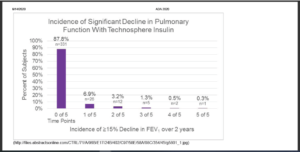
Acute Changes in Plasma Glucose Have Impact on Left Ventricular Systolic Function in Insulin-Treated Patients with Type 2 Diabetes
Andreas Anderson evaluated the acute changes in plasma glucose having impact on Left ventricular systolic function in Insulin treated T2D patients. This study was presented at the Virtual 80th Scientific Sessions. Patients with type 2 diabetes (T2D) have a markedly altered cardiac metabolism and twice the risk of developing heart failure compared to individuals without diabetes. The effect of acute changes in plasma glucose (PG) on cardiac function is unclear.
The author studied the effect of acute hyperglycemia and hypoglycemia on cardiac function. Insulin-treated patients with T2D (N=21, [mean±SD] age 62.8±6.5 years, BMI 29.0±4.2 kg/m , HbA 51.0±5.4 mmol/mol) and matched controls (N=21, age 62.2±8.3 years, BMI 29.2±3.5, HbA 34.3±3.3 mmol/l) with normal glucose tolerance underwent a 3-step glucose clamp day with 30 min of steady-state PG during each step: 1) fasting PG (FPG), 2) hyperglycemia (FPG+10 mmol/l), and 3) hyperinsulinemic hypoglycemia (PG<3.0 mmol/l).
Echocardiography was used to evaluate cardiac function during steady-state of each step. Acute hyperglycemia increased left ventricular ejection fraction (LVEF) from baseline in T2D patients ([mean±SEM, P-value] 4.5±1.7%, P=0.0108) whereas no change was observed in controls (2.0±1.7%, P=0.2525). Furthermore, left ventricular systolic function measured by s’ increased during hyperglycemia in both patients and controls (0.4±0.1 m/s (P=0.0007) and 0.6±0.1 m/s (P <0.0001), respectively) whereas global longitudinal strain rate only increased in the controls (-0.05±0.04 s (P=0.1803) and -0.11±0.04 s (P=0.0053), respectively). All measures of left ventricular systolic function increased markedly during hypoglycemia (P<0.01 for all). No significant interaction between group and PG level on cardiac function was observed.
Conclusion: In conclusion, the authors demonstrated that LVEF increases during acute hyperglycemia in insulin-treated patients with T2D and that acute hypoglycemia markedly increases all measures of left ventricular systolic function. These results point to the importance of glycemia when evaluating left ventricular systolic function by echocardiography in patients with T2D.
The Gut Microbiome in Adults with Prediabetes and Effect of Dietary Glycemic Index
Kristina Utzschneider presented her findings on gut microbiome in adults with prediabetes and its effect of dietary glycemic index at the Virtual 80th Scientific Sessions. Compositional and functional differences in gut bacteria exist between adults with normal glucose tolerance, IGT and type 2 diabetes and can change with dietary factors.
The author compared the gut microbiome between adults with impaired fasting glucose (IFG), impaired glucose tolerance (IGT) and IFG+IGT and evaluated the impact of dietary glycemic index (GI) on the gut microbiome. The study enrolled 53 adults (mean±SEM: age 53.0±1.4 y, BMI 32.5±0.9 kg/m ) with IFG (n=20), IGT (n=10) or both IFG+IGT (n=23). Stool samples were collected in RNA later after 2 weeks on a control, moderate GI diet (GI 55-58) and again after a 4 week dietary intervention of a low GI (GI<35, n=18) or high GI diet (GI>70, n=18 on placebo and n=17 on the antioxidant N-acetyl-cysteine 1200 mg po BID). Diets had the same macronutrient composition (55%carbohydrate/30% fat/15% protein) but more fiber in the LGI (65.1±2.2 g/d) vs. HGI diet (25.8±0.8 g/d). The stool microbiome was analyzed using 16S rRNA gene sequencing (V1-V3)
The study results depicted that diversity was significantly higher in IGT vs. IFG+IGT (7.2±0.08 vs. 7.0±0.06, p<0.05). Linear regression analysis adjusted for age, sex, BMI, race and sequencing plate showed 3 genera differed across groups on the control diet: Fusicatenibacter (p=0.01) and Lachnospiraceae UCG-008 (p=0.02) were lower in IGT vs. IFG+IGT; Oxalobacter was reduced in IFG (p=0.04) and enriched in IGT (p=0.004) vs. IFG+IGT. After 4 weeks on LGI or HGI diets α diversity did not differ and NAC had no effect on the microbiome. Adjusted regression analysis showed only the genus Anaerostipes differed, being higher in the LGI group (p<0.0001).
Conclusion: IGT and IFG+IGT showed differences in microbiota. These associations may contribute to poorer metabolic function in IFG+IGT, but would need further testing to determine cause and effect. The LGI diet was associated with higher Anaerostipes, a butyrate producing bacteria with beneficial anti-inflammatory effects. This may be related to the higher fiber content of the LGI diet.
Islet Autoimmunity Is Highly Prevalent and Associated with Diminished Beta-Cell Function in Patients with Type 2 Diabetes (T2D) in the GRADE Study
BARBARA BROOKS-WORRELL evaluated Islet autoimmunity in the GRADE STUDY which was presented at the Virtual 80th Scientific Sessions. The author hypothesized that islet autoimmunity, previously considered the pathophysiologic basis of type 1 diabetes (T1D) and latent autoimmune diabetes of adults (LADA), could contribute to ß cell dysfunction in patients with type 2 diabetes (T2D). To evaluate this question, the Glycemia Reduction Approaches in Diabetes: A Comparative Effectiveness (GRADE) Study – Beta Cell Ancillary Study Network measured humoral islet autoimmunity (autoantibodies against 65 kDa glutamic acid decarboxylase (GAD65-Ab), islet autoantigen-2 (IA2-Ab) and zinc transporter-8 (ZnT8-Ab)) in 392 participants (age 57.2 ± 10.1 y; BMI 33.5 ± 6.2 kg/m ; diabetes duration 4.0 ± 3.0 y; HbA1c 7.5 ± 0.5 %; on metformin as the sole glucose-lowering medication), and cellular islet autoimmunity (T cell autoreactivity against a broad range of islet antigens) in 322 of the same participants. 41.4% had evidence of cellular islet autoimmunity and 13.5% had evidence of humoral islet autoimmunity, but only 5.4% had both. T cell autoreactivity to islet antigens, but not autoantibody-positivity, was associated with diminished ß cell function, as assessed by the ratio of incremental area under the curve (iAUC) of C-peptide to iAUC of glucose during 0-120 min of an OGTT (ß = -0.1403; se = 0.0612; p = 0.0219) or ΔC-peptide/Δglucose during 0-30 min of an OGTT (ß = -0.2113; se = 0.0728; p = 0.0037), adjusted for insulin sensitivity. T cell positive participants also had higher fasting plasma glucose (p = 0.045) and HbA1c (p = 0.001) than T cell negative participants.
Conclusion: The study findings indicate that islet autoimmunity in T2D patients is far more prevalent than previously recognized; T cell mediated islet autoimmunity is associated with diminished ß cell function.
SGLT2i’s
Chantal Matheiu presented the Adjunctive Glucose-Lowering Therapies for Adults with Type 1 Diabetes—Evidence SGLTi’s at the Virtual 80th session of ADA. Glycemic related unmet needs are Glycemic control not optional, Risk of severe hypoglycemia and weight gain is high, glucose variability is high, and burden of day to day glycemic management on the individual is high. Along with this the other unmet needs are Control of CV risk factors, morbidity & mortality from CVD is high.The key trials conducted till date for SGLT2i’s are EASE program, DEPICT trials and InTANDEM trials. The DEPICT trials 1 & 2 conducted for Dapagliflozin in T1D have a multinational buildup so they are recruited in countries all over the world. The key inclusion criteria for this study was mainly T1D, age, Insulin dose≥0.3 U/kg/day. In the trial, patients with HbA1c ≥7.5 to ≤10.5% were randomized in 1:1:1 ratio. The study was conducted upto 52 weeks and followed upto 56 weeks.
The other trial conducted was TANDEM trial for Sotagliflozin in T1D.The primary outcomes of the study were a combination of patients achieving HbA1c <7.0% and no episode of Severe hypoglycemia(SH) or Diabetic Ketoacidosis (DKA)at week 24. The secondary endpoint was HBA1c. The TANDEM program also showed a pooled analysis of 24 week continuous glucose monitoring data.
Thirdly the EASE trial was conducted for Empagliflozin in T1D patients. In EASE 3 trial had all the dose of empagliflozin was used i.e. 2.5 mg, 10mg and 25 mg. The EASE 3 trial lasted for 26 weeks. In Ease 3 trial an intermediate effect of lowering HbA1c was seen with empagliflozin 2.5 mg. A reliable drop in body weight was also observed.
Conclusion: The pooled analysis, SGLT inhibitors are promising adjunct in therapies in T1D. Hypoglycemia, weight gain and glucose variability weigh on quality of life people with T1D.
